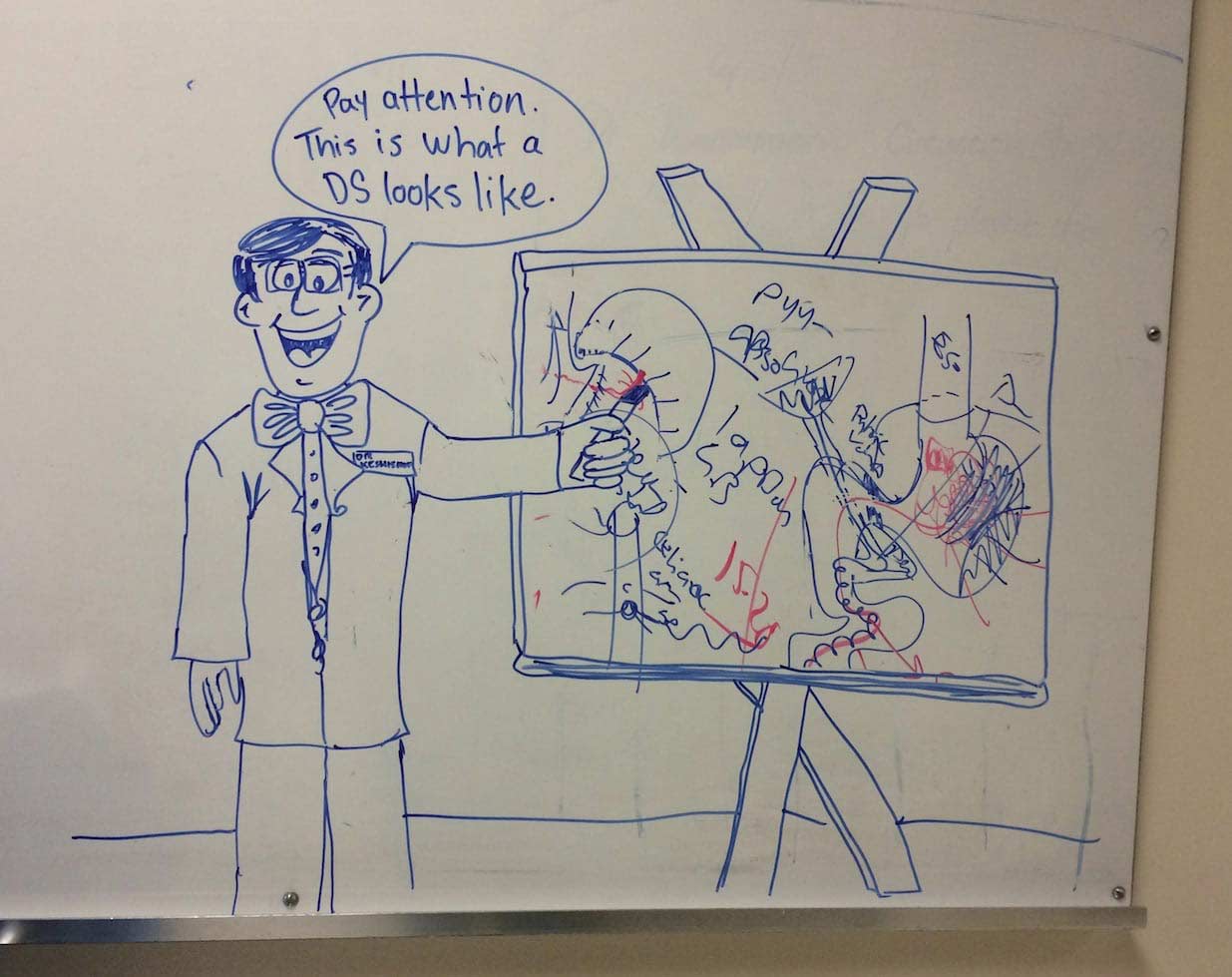Category: Hess method
Stapled Anastomosis
December 30, 2019 11:23 am
As I was looking over old archives, I came across the following pictures that were taken years ago. These were photographs taken to demonstrate the technique for the construction of the anastomosis of the biliopancreatic channel and alimentary channel of the Duodenal Switch.
The steps of doing the stapled anastomosis of the Duodenal Switch is generally unchanged during the laparoscopic approach to the procedure.
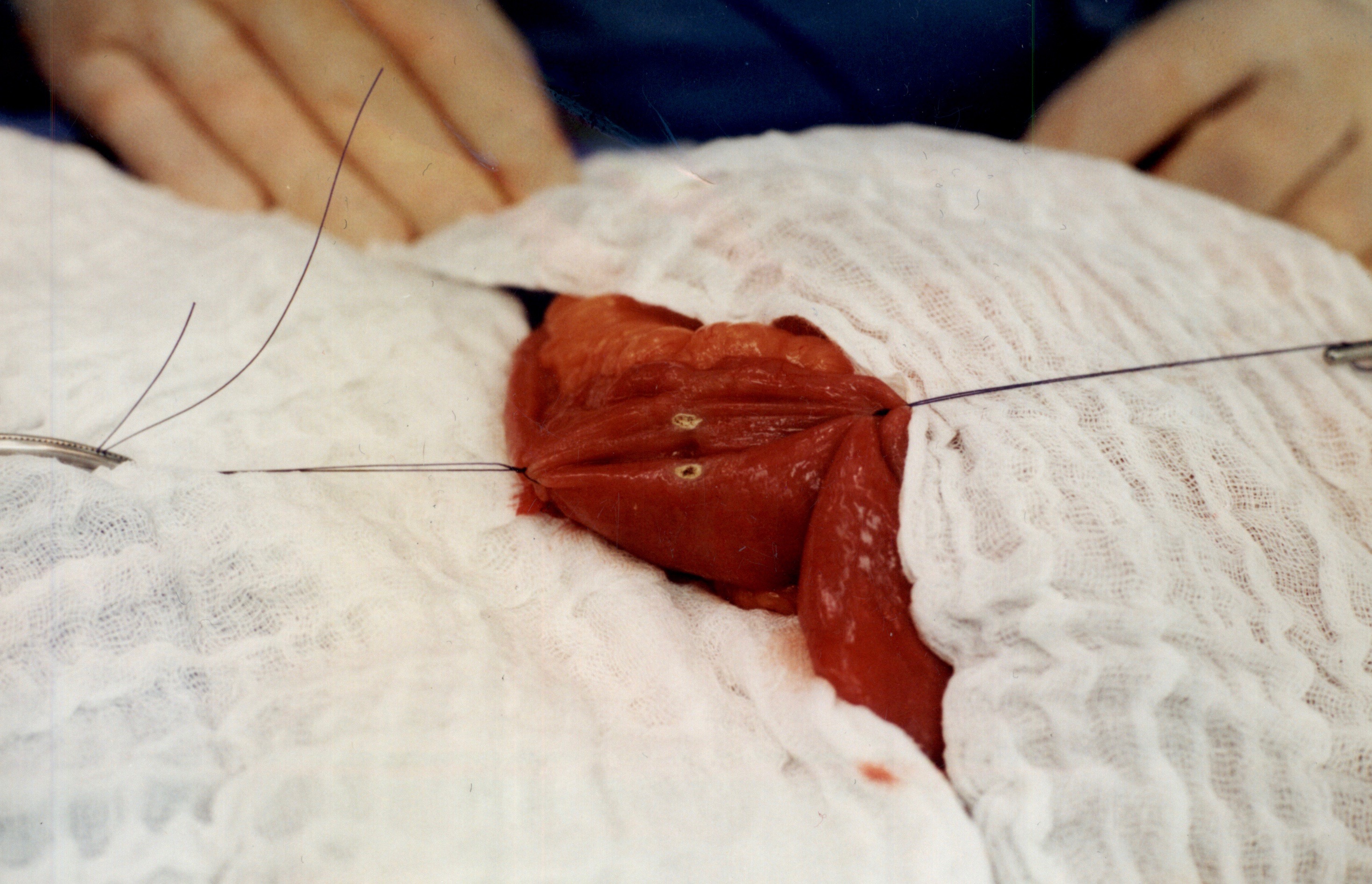
The stitches are placed to secure the bowel together. Two small openings are made in each limb of the bowel to be stapled together (the biliopancreatic limb on the bottom and the alimentary on the top of the image).
It is important to also align the bowel in the same peristalsis direction. This means that the contraction and the relaxation motion of the bowel should all point in the same direction. This should reduce the risk of complications such as intussusception.
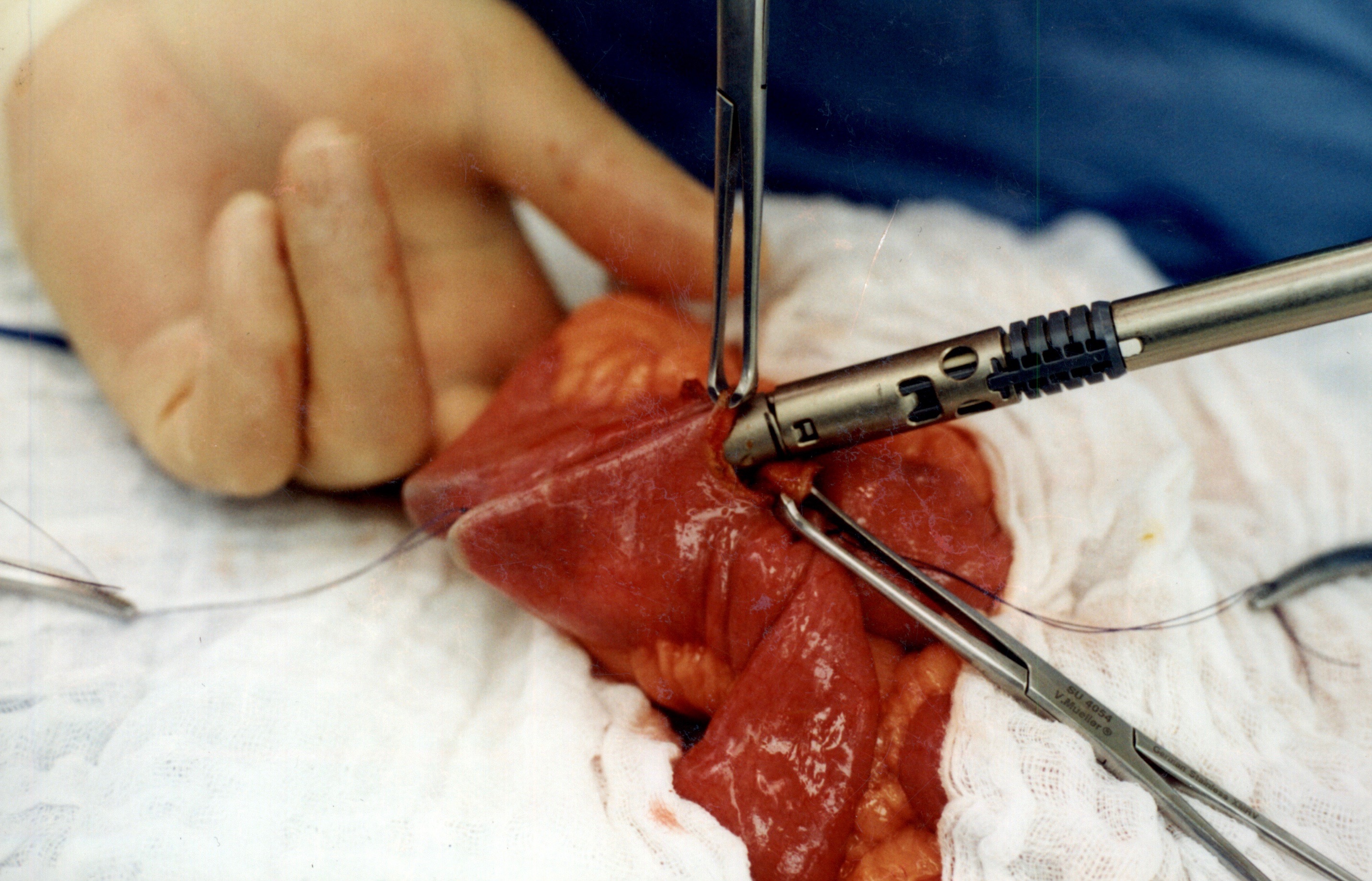
When the stapler is fired in opposite direction, a very wide anastomosis is created.
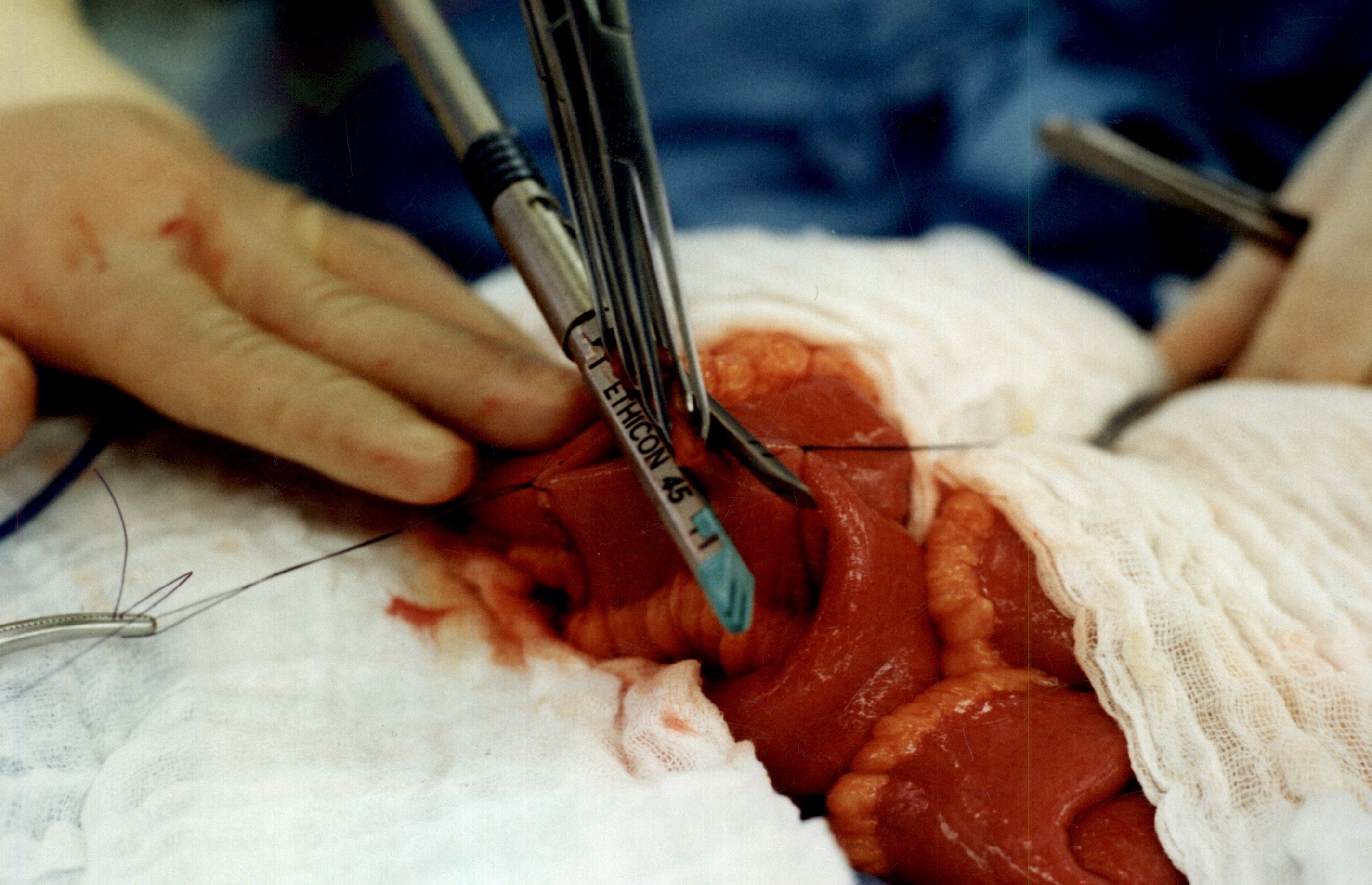
Once the anastomosis is created, then the last staple is used to close the opening that was made. This staple line is perpendicular to the direction of the anastomosis to avoid making the opening narrow.
We originally published this technique in 2003 on Obesity Surgery Journal.
Dr. Facebook
March 22, 2019 8:24 am
We have become reliant on the information that we obtain from the internet, specifically platforms such as Facebook. In our practice we have to continuously correct information that patients have obtained from other patients, unmonitored sites, blogs, and postings. Most of this information is based on individual experiences that has become gospel. “Fat is good for you” is one of them. To clarify, some health fat (olive oil, avocado, Omega 3) is healthy and needed for all patients. We do not recommend “fat bombs” as a part of ones daily dietary intake.
The following article was written on the accuracy of nutritional posts in support groups on Facebook.
Koalall et. all in SAORD, December 2018 Volume 14, Issue 12, Pages 1897–1902 published
“Content and accuracy of nutrition-related posts in bariatric surgery Facebook support groups”
The conclusion, as suspected, that “Over half of the posts contained inaccurate content or information that was too ambiguous to determine accuracy..:”
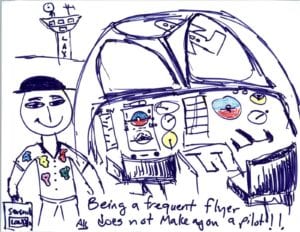
It is our recommendation before any dietary recommendations are taken from facebook and the like, the source of the information should be verified. As I have stated in the past, a frequent flier passenger is probably not qualified to fly a
commercial airplane, any more than a previous weight loss surgical patient providing medical and nutritional advice. We realize that there is significant value to the forum for exchange of information and sharing of experiences with other weight loss surgical patients as long as the information is well sourced and verified.

Insurance Appeals And Denials
August 07, 2017 7:08 am
Whenever you are dealing with insurance issues it is important to have a general understanding of insurance ins and outs. The Obesity Action Coalition has a good general guide to the insurance process here. If you are having issues with out of network, out of area, or insurance appeals and denials for Duodenal Switch, there may be some additional assistance from two individuals who have had the Duodenal Switch procedure themselves. We are grateful that they have provided assistance throughout the years to the Duodenal Switch community. The following is their statement on insurance.
The majority of insurance companies are in the business of making money (for profit). They can deny requests for preauthorization with impunity. These denials are often complexly worded and difficult to comply with and overcome, and are definitely overwhelming to the patient, and the busy surgeon’s office. The vast majority of patients faced with demanding if not impossible to achieve prerequisites, or denial of the request for preauthorization simply give up, and the insurance companies pocket the savings.
If you find yourself facing impossible pre-op hurdles, or a denial, we urge you to appeal, and to seek assistance in preparing the appeal. You can hire an attorney, of course, but there is an informal and free resource we suggest that you investigate as well.
If you go to BariatricFacts.org (a non-profit, patient-run site), you will find individuals who are long-term DS postops, and patient advocates. They have been helping patients, pro bono (for free), for over 10 years. They will help you draft your appeal letters, provide supporting medical and legal documentation, and prepare draft letters of medical necessity to be reviewed and signed by your surgeon supporting your appeal. They will not represent you directly, but they will help you best represent yourself. in many cases it is necessary to exhaust all internal appeals (because the insurance companies are unlikely to overrule themselves), and then file for external review, where independent reviewers often overrule improper denials. If you join and then post on BariatricFacts.org asking for help, you will be connected with them and you can decide if you want their help.
Please note that this is just a suggestion. It is neither legal nor medical advice, nor a guaranty regarding their services, and you should always consider getting legal advice and assistance from an attorney who will represent you directly. The members at BariatricsFacts.org will help you draft your own letters, but will not be your legal or medical representatives; you will be required to do a fair amount of your own work on your appeals, and to sign them yourself.
It is suggested that before or at the same time as you contact the resources suggested at the site, you gather as much of the following information as you can:
- A copy of your Evidence of Coverage, which is the usually 100+ page insurance contract between your employer and the insurance company, which you can obtain it from your HR department. If you are self-insured, it will be available directly from your insurance company. Note: it is NOT the Summary of Benefits – it needs to be the contract itself.
- If your insurance is through an employer, you need to determine whether your plan is self-funded or fully-funded. Your rights are significantly different under the two types of plans.
- If your insurance company has a separate bariatric surgery policy, provide a copy of that, too.
- A copy of your surgeon’s request for preauthorization, which provides the ICD-10 and CPT codes submitted.
- A copy of your denial letter, including the section regarding your appeal rights.
* It is strongly recommended that you obtain a copy of your surgeon’s LOMN (letter of medical necessity) before it is submitted to your insurer or for external review, so we can assist your busy surgeon in making the strongest possible case for you.
Don’t be deterred by a denial. It is unfortunately more common than it should be, but it can often be overcome if you meet the requirements for bariatric surgery, if you get help navigating the process.
Shared Success Story Update- Cyndi RNY to Duodenal Switch
June 06, 2016 6:37 am
Three Years Out Cyndi E … RNY to Duodenal Switch Revision
The Journey to get to the three year mark, has been amazing! And truly, The JOY is in the JOURNEY.
I am a JOYFUL “Third Time’s the Charm Revisionista”…. This is my new title…. And I say this proudly!!
For too many years (like 45! at least) I carried the shame and blame of being overweight and beat myself up on the inside. I tried everything, from age 13. I tried every diet, every program, and yes, I will say it, I have had THREE, yes THREE surgeries. And then, I let others convince me, and I bought into this, that I was a failure… BUT, I am not a failure. Surgery fails. For a long time, I could not say that, again with the SHAME word. BUT, I am done with shame, and I am done with blame. I no longer blame myself and I no longer shame myself or my body, because now, she and I, my body and I, are friends, and we are nice to each other.
Thankfully for me, I was in the right place at the right time, and met Dr. Ara Keshishian… My story with Dr. Keshishian, is simple. Dr. K was the first Doctor that did not blame me for my weight. He explained that each weight loss surgery has different measures of success, and percentages by weight loss surgery and outcomes. He educated me. He did not blame or shame me, he encouraged me. He also did an Endoscopy and found that I has a Gastro-Gastric Fistula. Simply put, this was an abnormal connection between the bypassed stomach and the small pouch created by the RNY Gastric Bypass surgery. Food could travel two ways, thus rendering the Gastric Bypass ineffective causing weight gain.
Dr. Keshishian performed my revision from RNY to Duodenal Switch on May 31, 2013. The procedure corrected my anatomy, enabling me to lose weight and regain my health. I have no complications, no issues post surgery.
Today, being a “Three Year Old” RNY to Duodenal Switch revisionista, I have a better perspective as a relative “newbie”. I am not a prisoner of my weight. I have lost 125-130 pounds, I am 5’12” (6 feet lol) 61 years old and for the first time in my life at a NORMAL WEIGHT! I do not fear, any longer, that I will gain my weight back. I am, however, mindful that I am consistent in my new habits and patterns that I have put in place, that keep me on track. I am also accountable. To myself, also to my Weight Loss Support Group, here in Paso Robles, to some fellow DS girlfriends that
I talk with about challenges, and with Dr. Keshishian. I am not held captive by my limitations, or my weight, and now I live with the possibilities each day brings and the fun challenges I put in front of me to conquer.
To the “newbies” I say, please take your time, treat yourself kindly, with your inner voice. This is not a race, this is a journey. Don’t rush, it’s ok to take it slow, listen to your body. And do not compare your journey to anyone else. You are you! You do you! You can do this well, one day at a time. Listen to the sage advice of those who went before you. We too have learned by trial and error. Be willing to sacrifice in the short term, for the gift of the long term life. Your DS is forgiving, you be forgiving as well!!!
Remember: WATER, PROTEIN, SUPPLEMENTS, EVERYTHING ELSE, EAT CLOSE TO THE DIRT, ELMO DIET
With JOY, Cyndi
Inadequate Weight loss and Weight Regain
May 24, 2016 7:56 am
There were numerous causes for the inadequate weight loss and or weight regain after weight loss surgery.
These factors may include:
1-Type of the surgery: Duodenal Switch, RNY, Adjustable Gastric Banding, Intragastric Balloon, etc.
2-Patients metabolic state (age, activity level, hormones state etc)
3-Co-morbidities
4-Patient compliance
5-Other
Each and every one of these may be an independent factor or may be a contributing cause.
In our experience, patients non-compliance is not as common as others believe. Frequently, we see patients in our office where they have been told that the poor outcome of the surgery is “their fault”
We see this with RNY, and Band patients as well as some of the duodenal switch patients who are seeking advice for weight regain or inadequate weight loss.
I would like to talk about the issues of inadequate weight loss or regain post Duodenal Switch specifically. Duodenal switch operation as described by Dr. Hess, outlined the division of the small bowel lengths to be proportional to each and every patients own total bowel lengths. This meant that two patients with the same BMI and weight will end up with two different lengths for common and alimentary limbs if there total length of the bowel is different. Unfortunately, too often patients are given a “standard” or “set” ( not clear what that word means, since there is no established standard in the literature) length for common channels and alimentary channels regardless of the total small bowel length. In some patients, those lengths may result in acceptable weight loss. However, quite frequently a patient with a preselected length for the common and alimentary limbs will end up either loosing too much weight and have nutritional problems or not loose adequate weight. As with all practices, we have over the years had patients who have had nutritional deficiencies and excessive weight loss or have had inadequate weight loss. Looking at the raw numbers however, we have had more patient from other practices that have come to us for revisions and corrections of lengths of the bowel lengths from other practices that our own patients have required.
Another level of the confusion is the improper interchanging of the “SIPS and SADI” procedures with the duodenal switch operation. As I have said in the past repeatedly, SIPS and SAID are not the same as the duodenal switch- and attempt to call these different procedures the same is misleading to say the least.
The other category of weight regain or inadequate weight loss includes medications and new health issues. Discussed in a previous blog, there are many medications that can influence weight gain. It is important to work with your health care provider to find medications that have a positive effect on symptoms without added side effects whenever possible.
In summary, weight re-gain or inadequate weight loss can have many facets. However, surgical technique can provide an advantage. Each aspect should be addressed and identified.
Teaching Nursing Students about Duodenal Switch!
October 19, 2015 11:34 am
Dr. Keshishian explaining the different weight loss surgical procedures to nursing students. Including the duodenal switch before cases to a number of nursing students on a board in the operating room. Dr. Keshishian is always willing to educate and draw with a smile but not always with a bowtie!
Cindy Porcell, Surgical tech put the finishing touches on it.
In case you are wondering, surgical scrubs do not have bowties!
Iron Deficiency & Anemia July 15, 2015 Webinar RecordingExclusive Member Content
July 16, 2015 1:52 pm
Duodenal Switch is a Safe Operation for Patients who have Failed Other Bariatric Operations
May 07, 2015 7:06 am
Obesity Surgery, 14, 1187-1192
Duodenal Switch is a Safe Operation for Patients who have Failed other Bariatric Operations
Ara Keshishian, MD, FACS; Karin Zahriya, MD, FACS; Teny Hartoonian, MD; Chris Ayagian, MD
Department of Surgery, Delano Regional Medical Center, Delano, CA, USA
Background: The incidence of morbid obesity and its surgical treatment have been increasing over the last few years. With this increase, there has been a rise in the number of patients who have had less than desirable outcome after bariatric operations. We perform the duodenal switch (DS) in patients for whom other weight loss surgical procedures have failed, because of inadequate weight loss, weight regain or significant complications, such as solid intolerance or dumping syndrome.
Method: From November 1999 to March 2004, 46 revisional surgeries were performed at our institution. The data was prospectively collected and reviewed, based on a number of parameters. Operative details, perioperative morbidity, and results are reported.
Results: 46 patients had their original bariatric surgical operation revised to DS. This resulted in complete resolution of their presenting complaints. The %EWL was 69% at the time of publication, with a mean lapsed time of 30 months.We had no mortality. Anastomotic leak occurred in 4 patients, 2 in our first
8 patients. We also noted that the majority of the patients were not aware of all the surgical procedures available to them at the time of their original operation.
Conclusion: In patients in whom gastroplasty, gastric bypass or both have failed to provide adequate weight loss, or worse have resulted in complications, DS can be performed as a safe revisional operation. The revision of other failed bariatric operations to DS results in both weight loss and resolution of the complications.
Introduction
Since its inception in the 1960s, weight loss surgery has been the only option for morbidly obese patients who have been unable to lose and maintain adequate weight loss through conventional non-surgical methods. In 1991, the NIH released a consensus on gastrointestinal surgery for severe obesity[1],which sparked further interest in the surgical treatment of morbid obesity, leading to an increase in the number of bariatric operations. This increase and the occasional failure and complications after these surgical procedures have resulted in an increased need for revisional surgery.
Bariatric procedures can be classified into three groups: those that restrict food intake, those that limit absorption, and those that utilize some degree of both components. Restrictive operations create a tiny neogastric pouch and a restrictive gastric outlet to decrease food intake.
Vertical banded gastroplasty (VBG) partitions the stomach along the lesser curvature, creating a channel restricted by an externally placed band. The upper pouch is approximately 5 cm long with a diameter of 1.5 cm and accommodates a volume of 20-40 ml. Gastric banding is another restrictive procedure, extensively performed in Europe and Australia, and recently in the United States. The published data varies significantly, with some reports showing <50% loss of excess body weight 9 years following the procedure.[2]
Roux-en-Y gastric bypass (RYGBP) is primarily restrictive, but also limits absorption of calories and nutrients to a varying degree. This procedure involves division of the stomach to create a tiny proximal pouch with approximate volume 15 ml. This pouch is then anastomosed to a Roux-en-Y jejunal limb, bypassing the stomach, pylorus and duodenum, adding a limited malabsorptive component. Although the original descriptions of RYGBP defined the Roux-limb to be <100 cm, in almost all of the RYGBP revisions, we have measured the Roux-limbs to be >100 cm.
The biliopancreatic diversion with duodenal switch (DS) is a hybrid operation involving both components of weight loss surgery. In the DS, a lateral gastrectomy provides a restricted gastric volume of approximately 100 cc, while excess fat absorption is limited by shortening the functioning length of the intestine. This involves diversion of the biliopancreatic secretions by partitioning the bowel into two limbs – an alimentary channel, and the biliopancreatic (afferent) limb. These two limbs of small bowel are reconnected to form the common channel.[3][4] DS appears to be the most effective bariatric operation to date. It produces the most sustained weight loss, without the unwanted side effects present with other bariatric operations (i.e. dumping syndrome, marginal ulceration, and solid food intolerance).[5][6] This is accomplished without any increase in the perioperative morbidity and mortality rate.
Restrictive operations have had varying results in long-term weight loss and complications.[7] Van Gemert et al.[5] reported a 12% incidence of revision after RYGBP and a 56% incidence of revision after VBG.[8] The need for revision after gastric banding has also been reported.[2][9]
Revision of failed bariatric procedures has resulted in morbidity rates of 12-41%. The perioperative revision complication rate has been three times higher when compared to a primary procedure. Gagner reported a morbidity rate of 22%.[10]
Behrns et al.[11] studied the choice of procedure for revisional surgery. They reported that when the primary operation had been a VBG, the most effective second operation was the RYGBP. The question arises as to what revisional surgery should be performed for failed RYGBP. The majority have been revised to a distal RYGBP. [11][12][13][14] However, Fobi et al.[14] showed that this was accompanied by only moderate weight loss and a protein malnutrition rate of 23%. Owens[15] and Schwartz[16] advised against revision of an operation performed satisfactorily, to one of the same type, because it is unlikely to produce a significant benefit.
Between November 1999 and March 2004, we performed 614 primary DS operations with excellent weight loss and minimal (<2%) hypoalbuminemia. During the same period, we elected to perform the DS as our revision operation of choice on 47 referred patients, and the data on the latter are hereby presented.
Methods
From November 1999 to March 2004, 47 patients were referred to us for revision to a DS, a period when 614 primary DS operations were performed. The primary operation for the patients seeking revision had been VBG (16), RYGBP (26), and both (5). The five patients with both procedures had an initial VBG, later revised to a RYGBP and were now presenting for their second revision. All of our patients who underwent revisional surgery had either regained all (31) or some (>50% – 7) of their original weight loss, or had failed to lose sufficient weight (9). The other presenting complaints were: severe dumping syndrome (20); intolerance to solid foods (16); persistent nausea and vomiting (4); and severe gastroesophageal reflux disease (14) (Table 1).
In this series, all 19 patients who had severe dumping syndrome had also regained a significant amount of weight. This appears to contradict the notion that dumping syndrome is a beneficial sideeffect of RYGBP as a behavior modification tool.
All patients were assessed by the surgeon, and had psychological, nutritional and medical evaluations. Extensive preoperative education was carried out to
[table id=1 /]
ensure adequate informed consent, and to bolster postoperative compliance. The work-up before revisional surgery included: complete metabolic panel; mineral, vitamin and lipid profile; liver function tests; upper GI series, and upper endoscopy.
Surgical Technique
The revision of any previous bariatric operation to DS involves a thorough study of the patient’s existing anatomy. The work-up includes review of prior medical records whenever available, as well as a detailed examination of the patient, followed by an upper GI series and an endoscopy performed at our institution by the operating surgeon. The peritoneal cavity is entered through a midline laparotomy incision.
Revision from VBG to DS entails exposure of the greater curvature of the stomach by ligation of the short gastric vessels. The stomach is then accessed through a gastrotomy at the greater curvature. A linear stapler is then used to divide the band through the gastrotomy and the distal end of the vertical partitioned stomach. Lateral vertical subtotal gastrectomy is accomplished over a 39-Fr bougie. The gastrectomy resection line includes the previous VBG staple-line, to prevent ruminant gastric tissue with compromised blood supply.
Revision of the RYGBP to DS involves a significantly greater degree of planning. The earlier open Roux-en-Y procedures were more likely to have left behind a larger stomach pouch with an intact left gastric artery than those performed laparoscopically. The reason for this is that most of the pouches were based on the greater curvature (horizontal), and little dissection was performed involving the lesser curvature. With the laparoscopic RYGBP procedures, the gastrojejunostomy anastomosis has been performed on the lesser curvature, and the left gastric artery has been frequently transected. Without the short gastric arteries, the pouch relies on the esophageal branches for its blood supply. The Lap-RYGBP patients have smaller pouch sizes and are exposed not only to an increased risk of leaks, but also have the potential for occurrence of stricture as a result of the tenuous blood supply. This may explain the high incidence of gastro-jejunostomy strictures needing balloon dilatation after lap- RYGBP.
Revision of RYGBP to DS involves taking down the gastro-jejunostomy anastomosis without compromising the blood supply of the proximal gastric pouch. The greater curvature of the bypassed stomach is then mobilized by ligation of the short gastric vessels to the level of the splenic hilum. The gastric continuity is then reconstructed by linear or circular staple firing between proximal stomach pouch and the gastric fundus of the mobilized bypassed stomach through a gastrotomy opening on the greater curvature. The staple-line is then over-sewn by a 3- 0 Vicryl® in a running fashion. A lateral vertical subtotal gastrectomy is then performed over a 39-Fr bougie. This gastrectomy now includes both the previous gastric pouch and the bypassed stomach in continuity.
Small bowel continuity is restored by first taking down the Roux-limb, and reconnecting it in a sideto- side fashion at the previously placed biliopancreatic limb. The total length of the small bowel is measured on the anti-mesenteric side. The common channel and alimentary limbs are then based on the percentage of the total length of the bowel (8%-12% for common, and 35%-45% for the alimentary). All of the small bowel entero-enteric anastomoses, with the exception of the duodeno-ileostomy anastomosis, are done in a side-to-side fashion as previously described.[17]
The duodenal switch is then performed by first dividing the duodenum 5 cm distal to the pylorus. The alimentary tract is then pulled through a retrocolic plane to the right of the middle colic artery, and an end-to-side anastomosis is created between the end of the transected proximal duodenum and the anti-mesenteric side of the small bowel, with a linear stapler, reinforced with a 3-0 Vicryl® in a running fashion.
All patients also undergo liver biopsy, appendectomy and cholecystectomy at the time of the revision operation. A feeding jejunostomy tube is routinely inserted in the biliopancreatic limb distal to the ligament of Treitz, in all revisional operations.
Results
The mean age of the patients was 47.3 (33-64), 3.3 years older than the average age for primary DS. Average pre-revision body mass index (BMI) was 47.3 kg/m2 (range 24.5-73.7), and average pre-revision weight was 128.3 kg (range 76.0 to 214.3). This is comparable to averages of 50.6 kg/m2 and 143.4 kg respectively, for primary DS. The average time elapsed between the primary operation and revision was 11.8 years (range 2.7 to 23). The female to male ratio was 9:1 compared with 6:1 in our primary DS patients.
A questionnaire administered to all revision patients at the time of the initial presentation, revealed that 96.2% of patients had been unaware of other surgical weight-loss options at the time of their primary operation, even though at the time the other bariatric operations were available.
The findings on preoperative radiological and endoscopic evaluation are shown in Tables 2 and 3. [table id=2 /] [table id=3 /].
The average operative time for revisional patients was 3.5 hours (2.3-5.7), and the average length of stay was 4.8 days. For primary DS, this has been 1.7 hours and 3.2 days, respectively.
Peri-operative complications included leaks in four patients (8.5%), one wound infection (2.1%), and one hernia (2.1%). All four of our patients who had leaks had undergone a previous RYGBP. Two of the four patients had undergone both a VBG and a RYGBP, and DS was their second revision. Two leaks occurred in the first 8 patients, and the remaining 2 in the following 38 patients. Two of the leaks were at the site of gastro-gastrostomy anastomosis, and the other two were located at the site of the lateral gastrectomy, just proximal to the gastro-gastrostomy anastomosis. Two of the four patients with leaks required further surgical interventions to completely resolve their complications. The other two were treated with enteral feeding and NPO, with drainage by means of the closed suction drains placed at the time of the operation. There has been no protein malnutrition and no deaths. The leak-rate for our primary DS patients has been 0.9%
Following a mean elapsed time of 30 months since revision to DS, the average BMI has dropped from 48.9 to 29.2 kg/m2 and the %EWL has been 67%. Mean weight has fallen from 128 kg to 80 kg (P<0.0001). The presenting complications of the original surgery have resolved in 100% of patients who underwent revision to DS. The BMI has remained stable after revision of failed VBG and RYGBP at 2.4 years after the DS. The data is summarized in Table 4.[table id=5 /]
Discussion
As more patients undergo bariatric surgery for treatment of morbid obesity, an increase in the number of patients with the need for revision are encountered. In our experience, the most common indication for re-operative surgery was inadequate weight loss (15 out of 35 patients, 43%). This has been confirmed by others. The reason could be due to a technical failure (eg. anastomotic dilatation, staple-line disruption). In the majority of the patients, however, we found no clear technical explanation for the failure of the operation. In restrictive operations such as VBG, patients recognize the smaller capacity of their postoperative stomach, and frequently modify their diet to comprise mainly high-calorie liquids or foods such as ice-cream and milkshakes.[7] Intolerance to solid foods related to stricture or stenosis also makes patients resort to this type of diet. Gawdat[18] found that 61% of revised patients had had no abnormality found at the time of the revisional operation.
The average BMI of our patients at the time of their primary operation had been 51.8 kg/m2. Problematic weight loss in the super-obese has led to the proposition that some degree of malabsorption should be incorporated into bariatric operations in these patients.[19] We agree with this, and we recommend that the DS be the primary operation of choice for patients with super-obesity.
Revision from a primary restrictive operation to DS involves complete conversion of the previous operation to essentially normal anatomy before the DS operation is completed. This necessitates working on a gastric pouch or remnant with tenuous blood supply. Paying heed to this danger during the operation has allowed us to limit our complication rates to those of previously published data. It is evident from our experience that the rate of complications such as leaks is increased in revisional operations. Complication rates are higher after RYGBP revision, and 100% of our leaks occurred in patients with prior RYGBP.
Gastric bypass has been shown to have better weight loss than VBG, justifying previous revision of failed VBG. However, DS has been shown to have better overall and long-term weight loss than the RYGBP. Therefore, our revision patients should have better results than if they had been revised to another to RYGBP.
With regards to patients with failed RYGBP, the options promoted by others have been to revise to another RYGBP, or to add a malabsorptive component by lengthening the Roux-limb (i.e. distal gastric bypass). Neither option has been very successful. As reported by Fobi[14] and by Sugerman,[20] problems with protein malnutrition occasionally follow distal RYGBP. Others have opted to manage these patients with strict diets and anorectic drugs. These modalities failed before weight-loss surgery in these patients, and are unlikely to be beneficial at this stage. Our decision to convert failed RYGBP patients to DS has led to good weight loss results. Additionally, we have encountered no issues of protein malnutrition, partly because a larger stomach is left with DS compared to RYGBP.[21][22] The average size of the stomach remaining after primary DS or after DS for previously failed bariatric surgery is approximately 100 cc.
Conversion to DS resulted in weight loss in all patients, with an average weight loss per month of 5.4 kg (range 0.3-16.1). However, the increased risk of complications following the re-operation implores serious consideration of the primary reason for the revision. We believe that if the presenting complaint is exclusively that of weight gain or inappropriate weight loss, the increased risk does not warrant revision in patients whose preoperative BMI is lower than the guidelines set by the National Institutes of Health.1 However, in patients presenting with primary surgical complications, such as dumping syndrome, intolerance to solids or persistent nausea and vomiting, where the patient’s quality of life has deteriorated, DS is a highly successful procedure. Our data indicates that 100% of initial complaints were resolved following revision.
The other major consideration in revisional bariatric surgery is patient education. In this study, 96.2 % of the patients claimed that they were unaware of other weight-loss surgical options at the time of their primary operation. One could possibly question the validity of the informed consent at the time of the original operation. Our program incorporates an extensive preoperative education plan geared towards explaining the DS procedure in detail, clarifying the general risks of surgery, the resulting change in anatomy and the long-term follow- up requirements, including supplementation requisites to maintain vitamin, mineral and nutritional levels within normal limits. Patients undergoing DS as their primary operation are in addition required to attend group meetings for all other surgical procedures, in order to assure adequate informed consent. The surgeon has the duty to provide the patient with the information necessary for the patient to make an educated decision as to whether to consent to the recommended operation. For a patient to properly make that decision, all major surgical options, their advantages and disadvantages must be discussed. Patients who are fully aware of all their weight loss surgery options, will better select their primary operation, and will likely decrease their need for future revisional surgery. In our practice, we recommend that our patients not only attend group meetings but also seek a second opinion regarding other bariatric surgical procedures.
References:
[1. Gastrointestinal surgery for severe obesity. National Institutes of Health Consensus Development Conference Draft Statement. Obes Surg 1991; 1: 257-66]
[2. Martiknainen T, Pirinen E, Alhava E et al. Long-term results, late complications and quality of life in a series of adjustable gastric banding. Obes Surg 2004; 14: 648-54]
[3. Hess, DS, Hess DW. Biliopancreatic diversion with a duodenal switch. Obes Surg 1998; 8: 267-82]
[4. Marceau P, Hould FS, Simard S et al. Biliopancreatic diversion with duodenal switch. World J Surg 1998; 22: 947-54]
[5. Biron S, Hould FS, Lebel S et al. Twenty years of biliopancreatic diversion: what is the goal of surgery? Obes Surg 2004; 14: 160-4]
[6. Rabkin RA. The duodenal switch as an increasing and highly effective operation for morbid obesity. Obes Surg 2004; 14: 861-5]
[7. Arribas del Amo D, Martinez Díez M, Elía Guedea M et al. Vertical banded gastroplasty: is it durable operation for morbid obesity? Obes Surg 2004; 14: 536-8]
[8. van Gemert WG, van Wersch MM, Greve JWM et al. Revisional surgery after failed vertical banded gastroplasty: Restoration of vertical gastroplasty or conversion to gastric bypass. Obes Surg 1998; 8: 21-8]
[9. Chevalier JM, Zinzindohoué F, Douard R et al. Complications of laparoscopic adjustable gastric banding for morbid obesity: experience with 1,000 patients over 7 years. Obes Surg 2004; 14: 407-14]
[10. Gagner M, Gentileschi P, De Csepel J et al. Laparoscopic reoperative bariatric surgery: lessons learned to improve patients selection and results. Ann Surg 1993; 218: 646-53]
[11. -]
[12. Jones KB Jr. Revisional bariatric surgery – safe and effective. Obes Surg 2001; 11: 183-9]
[13. Benotti PN, Forse RA. Safety and long-term efficacy of revisional surgery in severe obesity. Am J Surg 1996; 172: 232-5]
[14. Fobi MAL, Lee H, Igwe D Jr et al. Revision of failed gastric bypass to distal Roux-en-Y gastric bypass: A review of 65 cases. Obes Surg 2001; 11: 190-5]
[15. Owen BM, Owen ML, Hill CW. Effect of revisional bariatric surgery on weight loss and frequency of complications. Obes Surg 1996; 6: 479-84]
[16. Schwartz RW, Strodel WE, Simpson WS. Gastric bypass revision: Lessons from 920 cases. Surgery 1988; 104: 806-12]
[17. Keshishiam A, Zahriya K. Stapled Roux-en-Y anastomosis: an illustrated technique. Obes Surg 2003; 13: 450-2]
[18. Gawdat K. Bariatric reoperations: are they preventable? Obes Surg 2000; 10: 525-9]
[19. Dolan K, Hatzifotis M, Newbury L et al. Comparison of laparoscopic adjustable gastric banding and biliopancreatic diversion in super-obesity. Obes Surg 2004; 14: 165-9]
[20. Sugerman HJ, Kellum JM, De Maria EJ. Conversion of proximal to distal gastric bypass for failed gastric bypass for superobesity. J Gastrointest Surg 1997; 1: 517-25]
[21. Yashkov YI, Oppel TA, Shishlo LA et al. Improvement of weight loss and metabolic effects of vertical banded gastroplasty by an added duodenal switch procedure. Obes Surg 2001; 11: 635-9]
[22. Rabkin RA, Rabkin JM, Metcalf B et al. Nutritional markers following duodenal switch for morbid obesity. Obes Surg 2004; 14: 84-91]




